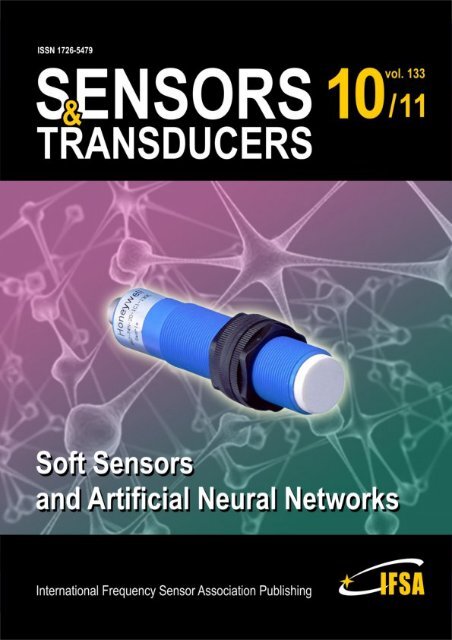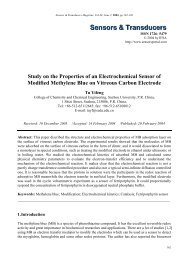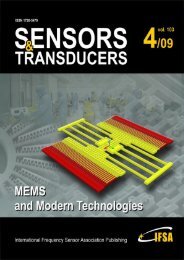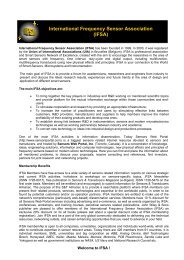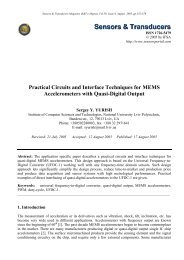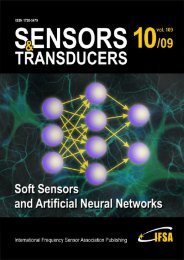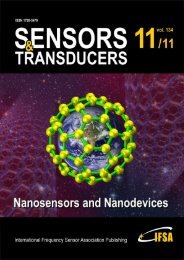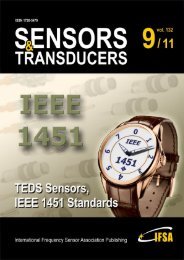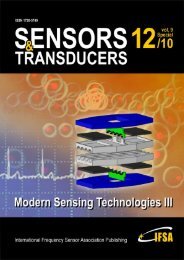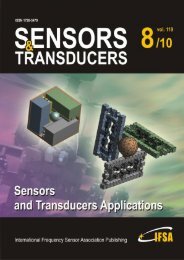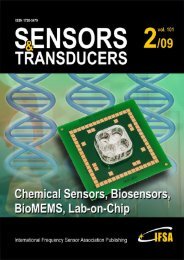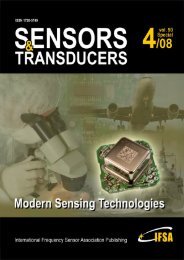Balancing Inverted Pendulum by Angle Sensing Using Fuzzy Logic ...
Balancing Inverted Pendulum by Angle Sensing Using Fuzzy Logic ...
Balancing Inverted Pendulum by Angle Sensing Using Fuzzy Logic ...
- No tags were found...
Create successful ePaper yourself
Turn your PDF publications into a flip-book with our unique Google optimized e-Paper software.
Sensors & TransducersVolume 133, Issue 10October 2011www.sensorsportal.com ISSN 1726-5479Editors-in-Chief: professor Sergey Y. Yurish, tel.: +34 696067716, e-mail: editor@sensorsportal.comEditors for Western EuropeMeijer, Gerard C.M., Delft University of Technology, The NetherlandsFerrari, Vittorio, Universitá di Brescia, ItalyEditor for Eastern EuropeSachenko, Anatoly, Ternopil State Economic University, UkraineEditors for North AmericaDatskos, Panos G., Oak Ridge National Laboratory, USAFabien, J. Josse, Marquette University, USAKatz, Evgeny, Clarkson University, USAEditor South AmericaCosta-Felix, Rodrigo, Inmetro, BrazilEditor for AfricaMaki K.Habib, American University in Cairo, EgyptEditor for AsiaOhyama, Shinji, Tokyo Institute of Technology, JapanEditor for Asia-PacificMukhopadhyay, Subhas, Massey University, New ZealandEditorial Advisory BoardAbdul Rahim, Ruzairi, Universiti Teknologi, MalaysiaAhmad, Mohd Noor, Nothern University of Engineering, MalaysiaAnnamalai, Karthigeyan, National Institute of Advanced Industrial Scienceand Technology, JapanArcega, Francisco, University of Zaragoza, SpainArguel, Philippe, CNRS, FranceAhn, Jae-Pyoung, Korea Institute of Science and Technology, KoreaArndt, Michael, Robert Bosch GmbH, GermanyAscoli, Giorgio, George Mason University, USAAtalay, Selcuk, Inonu University, TurkeyAtghiaee, Ahmad, University of Tehran, IranAugutis, Vygantas, Kaunas University of Technology, LithuaniaAvachit, Patil Lalchand, North Maharashtra University, IndiaAyesh, Aladdin, De Montfort University, UKAzamimi, Azian binti Abdullah, Universiti Malaysia Perlis, MalaysiaBahreyni, Behraad, University of Manitoba, CanadaBaliga, Shankar, B., General Monitors Transnational, USABaoxian, Ye, Zhengzhou University, ChinaBarford, Lee, Agilent Laboratories, USABarlingay, Ravindra, RF Arrays Systems, IndiaBasu, Sukumar, Jadavpur University, IndiaBeck, Stephen, University of Sheffield, UKBen Bouzid, Sihem, Institut National de Recherche Scientifique, TunisiaBenachaiba, Chellali, Universitaire de Bechar, AlgeriaBinnie, T. David, Napier University, UKBischoff, Gerlinde, Inst. Analytical Chemistry, GermanyBodas, Dhananjay, IMTEK, GermanyBorges Carval, Nuno, Universidade de Aveiro, PortugalBousbia-Salah, Mounir, University of Annaba, AlgeriaBouvet, Marcel, CNRS – UPMC, FranceBrudzewski, Kazimierz, Warsaw University of Technology, PolandCai, Chenxin, Nanjing Normal University, ChinaCai, Qingyun, Hunan University, ChinaCampanella, Luigi, University La Sapienza, ItalyCarvalho, Vitor, Minho University, PortugalCecelja, Franjo, Brunel University, London, UKCerda Belmonte, Judith, Imperial College London, UKChakrabarty, Chandan Kumar, Universiti Tenaga Nasional, MalaysiaChakravorty, Dipankar, Association for the Cultivation of Science, IndiaChanghai, Ru, Harbin Engineering University, ChinaChaudhari, Gajanan, Shri Shivaji Science College, IndiaChavali, Murthy, N.I. Center for Higher Education, (N.I. University), IndiaChen, Jiming, Zhejiang University, ChinaChen, Rongshun, National Tsing Hua University, TaiwanCheng, Kuo-Sheng, National Cheng Kung University, TaiwanChiang, Jeffrey (Cheng-Ta), Industrial Technol. Research Institute, TaiwanChiriac, Horia, National Institute of Research and Development, RomaniaChowdhuri, Arijit, University of Delhi, IndiaChung, Wen-Yaw, Chung Yuan Christian University, TaiwanCorres, Jesus, Universidad Publica de Navarra, SpainCortes, Camilo A., Universidad Nacional de Colombia, ColombiaCourtois, Christian, Universite de Valenciennes, FranceCusano, Andrea, University of Sannio, ItalyD'Amico, Arnaldo, Università di Tor Vergata, ItalyDe Stefano, Luca, Institute for Microelectronics and Microsystem, ItalyDeshmukh, Kiran, Shri Shivaji Mahavidyalaya, Barshi, IndiaDickert, Franz L., Vienna University, AustriaDieguez, Angel, University of Barcelona, SpainDighavkar, C. G., M.G. Vidyamandir’s L. V.H. College, IndiaDimitropoulos, Panos, University of Thessaly, GreeceDing, Jianning, Jiangsu Polytechnic University, ChinaDjordjevich, Alexandar, City University of Hong Kong, Hong KongDonato, Nicola, University of Messina, ItalyDonato, Patricio, Universidad de Mar del Plata, ArgentinaDong, Feng, Tianjin University, ChinaDrljaca, Predrag, Instersema Sensoric SA, SwitzerlandDubey, Venketesh, Bournemouth University, UKEnderle, Stefan, Univ.of Ulm and KTB Mechatronics GmbH, GermanyErdem, Gursan K. Arzum, Ege University, TurkeyErkmen, Aydan M., Middle East Technical University, TurkeyEstelle, Patrice, Insa Rennes, FranceEstrada, Horacio, University of North Carolina, USAFaiz, Adil, INSA Lyon, FranceFericean, Sorin, Balluff GmbH, GermanyFernandes, Joana M., University of Porto, PortugalFrancioso, Luca, CNR-IMM Institute for Microelectronics and Microsystems, ItalyFrancis, Laurent, University Catholique de Louvain, BelgiumFu, Weiling, South-Western Hospital, Chongqing, ChinaGaura, Elena, Coventry University, UKGeng, Yanfeng, China University of Petroleum, ChinaGole, James, Georgia Institute of Technology, USAGong, Hao, National University of Singapore, SingaporeGonzalez de la Rosa, Juan Jose, University of Cadiz, SpainGranel, Annette, Goteborg University, SwedenGraff, Mason, The University of Texas at Arlington, USAGuan, Shan, Eastman Kodak, USAGuillet, Bruno, University of Caen, FranceGuo, Zhen, New Jersey Institute of Technology, USAGupta, Narendra Kumar, Napier University, UKHadjiloucas, Sillas, The University of Reading, UKHaider, Mohammad R., Sonoma State University, USAHashsham, Syed, Michigan State University, USAHasni, Abdelhafid, Bechar University, AlgeriaHernandez, Alvaro, University of Alcala, SpainHernandez, Wilmar, Universidad Politecnica de Madrid, SpainHomentcovschi, Dorel, SUNY Binghamton, USAHorstman, Tom, U.S. Automation Group, LLC, USAHsiai, Tzung (John), University of Southern California, USAHuang, Jeng-Sheng, Chung Yuan Christian University, TaiwanHuang, Star, National Tsing Hua University, TaiwanHuang, Wei, PSG Design Center, USAHui, David, University of New Orleans, USAJaffrezic-Renault, Nicole, Ecole Centrale de Lyon, FranceJaime Calvo-Galleg, Jaime, Universidad de Salamanca, SpainJames, Daniel, Griffith University, AustraliaJanting, Jakob, DELTA Danish Electronics, DenmarkJiang, Liudi, University of Southampton, UKJiang, Wei, University of Virginia, USAJiao, Zheng, Shanghai University, ChinaJohn, Joachim, IMEC, BelgiumKalach, Andrew, Voronezh Institute of Ministry of Interior, RussiaKang, Moonho, Sunmoon University, Korea SouthKaniusas, Eugenijus, Vienna University of Technology, AustriaKatake, Anup, Texas A&M University, USAKausel, Wilfried, University of Music, Vienna, AustriaKavasoglu, Nese, Mugla University, TurkeyKe, Cathy, Tyndall National Institute, IrelandKhelfaoui, Rachid, Université de Bechar, AlgeriaKhan, Asif, Aligarh Muslim University, Aligarh, IndiaKim, Min Young, Kyungpook National University, Korea South
Sensors & Transducers JournalContentsVolume 133Issue 10October 2011www.sensorsportal.com ISSN 1726-5479Research ArticlesA Soft Technique for Measuring Friction Force <strong>Using</strong> Neural NetworkSunan Huang, Kok Kiong Tan............................................................................................................ 1Neural Net Based Optimization of Wet Thermal Lateral Oxidation Rates“Moh’d Sami” Ashhab, Nabeel Abo Shaban and Abdulla N. Olimat ................................................. 8ECG Acquisition and Analysis System for Diagnosis of Heart DiseasesChannappa Bhyri, Satish T. Hamde, Laxman M. Waghmare ............................................................ 18Soft Computing Based PID Controller Tuning and Application to the Pulpand Paper IndustryB. Nagaraj, P. Vijayakumar ................................................................................................................ 30Greenhouse Environmental Control <strong>Using</strong> Optimized MIMO PID TechniqueFateh Bounaama and Belkacem Draoui ............................................................................................ 44Design and Real Time Implementation of CDM-PI Control System in a Conical Tank LiquidLevel ProcessP. K. Bhaba and S. Somasundaram .................................................................................................. 53<strong>Fuzzy</strong> <strong>Logic</strong> Applied to an Oven Temperature Control SystemNagabhushana Katte, Nagabhushan Raju Konduru, Bhaskar Pobbathi and Parvathi Sidaraddi...... 65<strong>Balancing</strong> <strong>Inverted</strong> <strong>Pendulum</strong> <strong>by</strong> <strong>Angle</strong> <strong>Sensing</strong> <strong>Using</strong> <strong>Fuzzy</strong> <strong>Logic</strong> Supervised PIDController Optimized <strong>by</strong> Genetic AlgorithmAshutosh K. Agarwal, Sanjeev Kumar ............................................................................................... 74A Novel Method for Gearbox Fault Detection Based on Biorthogonal B-spline WaveletGuangbin Zhang and Yunjian Ge....................................................................................................... 83A Multi-hop Topology Control Based on Inter-node Range Measurement for WirelessSensor Networks Node LocalizationAli Husein Alasiry, Shinji Ohyama ...................................................................................................... 95Distributed Point Source Technique in Modeling Surface-Breaking Crack in a MFL TestMehdi Kiyasatfar, Maqsud Golzan, Nader Pourmahmoud, Mehdi Eskandarzade............................. 108Authors are encouraged to submit article in MS Word (doc) and Acrobat (pdf) formats <strong>by</strong> e-mail: editor@sensorsportal.comPlease visit journal’s webpage with preparation instructions: http://www.sensorsportal.com/HTML/DIGEST/Submition.htmInternational Frequency Sensor Association (IFSA).
Sensors & Transducers Journal, Vol. 133, Issue 10, October 2011, pp. 74-82Sensors & TransducersISSN 1726-5479© 2011 <strong>by</strong> IFSAhttp://www.sensorsportal.com<strong>Balancing</strong> <strong>Inverted</strong> <strong>Pendulum</strong> <strong>by</strong> <strong>Angle</strong> <strong>Sensing</strong><strong>Using</strong> <strong>Fuzzy</strong> <strong>Logic</strong> Supervised PID ControllerOptimized <strong>by</strong> Genetic Algorithm1Ashutosh K. AGARWAL, 2 Sanjeev KUMAR1Department of Electronics & Communication Engineering, Krishna Engineering College,Ghaziabad, 201009, IndiaTel.: +9199996454632Department of Mechanical Engineering, Ajay Kumar Garg Engineering College,Ghaziabad, 201007, IndiaTel. +919818187936E-mail: ashutosh@blueink.in, s.kumar@akgec.orgReceived: 2 July 2011 /Accepted: 25 October 2011 /Published: 31 October 2011Abstract: Genetic algorithms are robust search techniques based on the principles of evolution. Agenetic algorithm maintains a population of encoded solutions and guides the population towards theoptimum solution. This important property of genetic algorithm is used in this paper to stabilize the<strong>Inverted</strong> pendulum system. This paper highlights the application and stability of inverted pendulumusing PID controller with fuzzy logic genetic algorithm supervisor . There are a large number of wellestablished search techniques in use within the information technology industry. We propose a methodto control inverted pendulum steady state error and overshoot using genetic algorithm technique.Copyright © 2011 IFSA.Keywords: <strong>Inverted</strong> pendulum, Robotic arm, Genetic algorithm, <strong>Fuzzy</strong> logic, PID controller.1. IntroductionThe inverted pendulum is the classic nonlinear control experiment. In addition to being the simplestunstable non-linear system imaginable, it also provides a simple model for rocket control. Surprisingly,this dynamics continues to appear in numerous other systems of interest. The inverted pendulumdriven <strong>by</strong> a lateral acceleration is clearly present in the dynamic balance of a skier racing down the74
Sensors & Transducers Journal, Vol. 133, Issue 10, October 2011, pp. 74-82slope. In much the same way, simple models for exploring bicycle and motorcycle dynamics includethe inverted pendulum as key subsystem, imposing strong constraints on the system performance [1].An inverted pendulum is a pendulum which has its mass above its pivot point. It is often implementedwith the pivot point mounted on a cart that can move horizontally and may be called a cart and pole.Whereas a normal pendulum is stable when hanging downwards, an inverted pendulum is inherentlyunstable, and must be actively balanced in order to remain upright, either <strong>by</strong> applying a torque at thepivot point or <strong>by</strong> moving the pivot point horizontally as part of a feedback system [2, 3].In this paper, we propose a tuning method of the PID gains <strong>by</strong> using fuzzy logic to stabilize theinverted pendulum. The tuning method proposed here is to replace the human operator <strong>by</strong> fuzzy logic.In order to get fast convergence and attain the better solution for a local minimum problem, we adoptthe genetic algorithm to find parameter included in the fuzzy logic [4].1.1 1.1. Problem FormulationIt is virtually impossible to balance a pendulum in the inverted position without applying someexternal force to the system. The Carriage Balanced <strong>Inverted</strong> <strong>Pendulum</strong> (CBIP) system, shown inFig. 1, allows this control force to be applied to the pendulum carriage.Fig. 1. Carriage Balanced <strong>Inverted</strong> <strong>Pendulum</strong> (CBIP) system.<strong>Inverted</strong> pendulum [5] and cart system adopted in this paper consists of a straight line rail, the cartwhich can move left and right on the rail without friction, the pendulum which is hinged on the centerof the top surface of the cart and can rotate around the pivot in the same vertical plane with the rail andthe driving unit as shown in Fig. 2. It means that joint between cart and pendulum is a revolute joint(1-dimensional motion). The outputs from the CBIP rig can be carriage position, carriage velocity,pendulum angle and pendulum angular velocity (only pendulum angle in our case). The pendulumangle is fed back to controller which controls the servo-motor, ensuring consistent and continuoustraction.The aim of the study is to stabilize the pendulum such that the position of the carriage on the track iscontrolled quickly and accurately and that the pendulum is always maintained tightly in its invertedposition during such movements. <strong>Using</strong> Lagrangian technique we obtain the transfer function [6-8].The transfer function can thus be simplified as:(s)U(s)qs3 b(I ml2) s2mls mgl(M m)s bgml,(1)75
Sensors & Transducers Journal, Vol. 133, Issue 10, October 2011, pp. 74-82where22q ( M m)(I ml ) ( ml) (s) Laplace transform of the Angular position of the pendulum.Fig. 2. A Cart.If we neglect the friction in the system, that is, we take the coefficient of friction b=0,then(s)U ( s)s2KAP2P1,(2)whereandK 1 P ( M m ) gA P ( M( M m)mgl2 m)(I ml ) ( ml)2Thus, the linearized approximation transfer function for the IP has been obtained.1.2. Actuation MechanismThe actuation mechanism consists of a movable cart (on rail), driven <strong>by</strong> a DC motor via a pulley andbelt [8]. So the overall transfer function of the actuation mechanism will depend upon the transferfunction of “the DC Motor” and “the Pulley, Belt & Cart”.After considering the contribution of DC Motor, pulley, belt and cart we get the transfer function,(s)E(s)s Ks( ms1)(A22P1)(3)76
where K K K K r( M m)FPSensors & Transducers Journal, Vol. 133, Issue 10, October 2011, pp. 74-82ME(s) = Laplace transform of the Error Voltage, and (s) Laplace transform of the Angular position of the pendulumNow taking feedback into consideration the over all system takes the form as shown in Fig. 3. Herer(s) is reference input signal (unit step signal) and c(s)is output signal.PID Controller <strong>Inverted</strong> <strong>Pendulum</strong> + (s) e(s)rE(s) Servomechanism c(s)Feedback H(s)Fig. 3. <strong>Inverted</strong> <strong>Pendulum</strong> system with position feedback.The overall transfer function with feedback is: ( s)c ( s)rG(s)1G(s)H ( s),(4) ( s)c ( s)r1.78s2( s 4.356)( s 6.356s10.31)(5)There is a pole on the right hand side of the origin. So the feedback alone can not make the systemstable [9].1.3. Controller for the <strong>Inverted</strong> <strong>Pendulum</strong>Now we have two challenges for the upper described problem:1) Decrease the steady state error up to a maximum allowable range;2) Reduce the overshoot (or undershoot) and settling time.1.4. Parameters for Designing <strong>Fuzzy</strong> Supervised PID ControllerThe fuzzy PID supervisor described <strong>by</strong> Van Nauta Lemke and De-Zhao and Van Nauta Lemke andKrijgsman is based on a fuzzy supervisor and a PID controller [10, 11]. In their scheme the fuzzy77
Sensors & Transducers Journal, Vol. 133, Issue 10, October 2011, pp. 74-82supervisor has a rule base in which the fuzzy rules have consequents which address the gains of thePID controller. Hence, the fuzzy supervisor has three “outputs”: KP, KIand KDwhich result indifferent parameters of the PID controller each sampling instant:K'P'I[ kT] K K[ kT](6)PPK [ kT] K K[ kT](7)K'DII[ kT ] K K[ kT](8)DThe inputs of the fuzzy supervisor are: the error e [kT]and its first difference e[kT]. Or in otherwords the error and error rate are given as inputs to fuzzy system. We find that the error depends on K Ponly and the error is reducing with increase in value of K P . For K P 450, the steady state error is 2 %.First we will focus on the error only. We will design such a fuzzy logic supervisory system whichgives output in incremental form of K P for the given inputs e(t) and de/dt. The fuzzy supervisor willchange the value of K P so that the error is less than 2 %.Rewriting the equations:D2.55KDDamping ratio (9)2 2.55K 22.47PSettling time (on 2% basis)ts3.137 (10)KDError 22.47ess(11)2.55K 22.47P Maximum Overshoot = exp 10021 (12)The inverted pendulum system as in eq. (1) is analyzed at different stages. The open loop system(Servomechanism + <strong>Inverted</strong> <strong>Pendulum</strong>) has one pole on the right hand side, so the inverted pendulumis unstable in open loop. After introducing position feedback as in Fig. 3 and a feedback transferfunction H(s) =2.86, we get transfer function of the closed loop system. Still one pole is on the righthand side. Hence, this closed loop system is also unstable.[reference of same paper]2. Proposed SystemExisting system incorporates fuzzy controllers for stabilizing an inverted pendulum [9]. The error inthe system depends on K P only and the error is reducing with increase in value of K P , the steady stateerror being less than or equal to 2 % , for K P 450.This design has a fuzzy supervisory system whichgives output in incremental form of K P for the given inputs e(t) and de/dt [11].78
Sensors & Transducers Journal, Vol. 133, Issue 10, October 2011, pp. 74-82In the proposed system we have included a Genetic Algorithm system after the <strong>Fuzzy</strong> supervisor asshown in Fig. 4. Initially, fuzzy supervisor gives output in incremental form so that error is less than2 %, then the GA system finds the optimal solution in the range 264 K P 529, so that the error andthe overshoot both are minimum. In the proposed system coding of GA system has been done in C++language.Fig. 4. <strong>Fuzzy</strong> GA supervised PID Controller for IP System.2. Simulation ResultsAfter introducing fuzzy supervised PID-controller, we get a stable response of the system as shown inFig. 5. The fuzzy supervisor changes the value of K P so that the error is less than 2 % [11].Fig. 5. Response of inverted pendulum for an applied input.79
Sensors & Transducers Journal, Vol. 133, Issue 10, October 2011, pp. 74-82The values of KPobtained from fuzzy system is fed into GA system. The optimal value of K P isobtained on the basis of cost functionCost function = 0.8 + 0.2 overshoot(in this case) (13)eSSFigs. 6 and 7 are the step responses for K GA , where K GA is the value of K P obtained from GA system.Fig. 6. Step Response of the System at K P =456.Fig. 7. Step Response of the System at K P =410.3. ConclusionAs depicted in Fig. 8. the results from fuzzy system have been improved <strong>by</strong> GA system. The GAsystem finds such a value of K P for each input, so that the cost function is decreased for each input.80
Sensors & Transducers Journal, Vol. 133, Issue 10, October 2011, pp. 74-82Here we have given more weightage to error than overshoot. So the output values of K P are closer toupper limit (K P =529). If more weightage is given to overshoot, then the output values of K P will becloser to lower limit (K P =264).Comparison of cost functionCost Function2.22.182.162.142.122.12.082.062.042.0221 2 3 4 5 6 7 8 9 10 11 12 13 14 15 16 17 18 19 20 21Data PointsFig. 8. Comparison of Cost Function.KfuzzifiedKgaAs we can see in Fig. 8, the proposed controller gives the satisfactory response for the rule base offuzzy logic, and the results are further improved <strong>by</strong> the use of GA supervisor after <strong>Fuzzy</strong> logicSupervisor. Hence for the given design requirement the above simulated controller is satisfactory. Wealso can conclude that the system approaches towards stability with time.AcknowledgmentThe authors are grateful to the management of Krishna Engineering College for giving all the facilitiesrequired to carry out the work. We thank Prof S. B. Bajpayee and Prof T. Ramanujam for theirencouragement.References[1]. Hauser John, Saccon Alessandro, and Frezza Ruggero, On the Driven <strong>Inverted</strong> <strong>Pendulum</strong>, in Proc. of the44 th IEEE Conference on Decision and Control, and the European Control Conference, 2005,pp. 6176-6180.[2]. Furuta K., M. Yamakita M and S. Kobayashi, Swing-up control of inverted pendulum using pseudo-statefeedback, in Proceedings of the Institution of Mechanical Engineers, Part I: Journal of Systems andControl Engineering November, 206, no.6, 1992, pp. 263-269.[3]. A. Ohsumi and T. Izumikawa, Nonlinear Control of Swing-up and Stabilization of an <strong>Inverted</strong> pedndulum,in Proceedings of the 34 th Conference on Decision & Control, 1995, pp. 3873-3880.[4]. Wang Q., Spronck Pieter, and Tracht Rudolf, An overview of Genetic Algorithms Applied to ControlEngineering Problems, in Proc. of the International Conference on Machine Learning and Cybernetics,2003, pp. 1651 – 1656.[5]. Kui Fu Chen, Standing Human - an <strong>Inverted</strong> <strong>Pendulum</strong>, Lat. Am. J. Phys. Educ., Vol. 2, No. 3, Sept. 2008.[6]. W. Zhong and H. Röck, Energy and Passivity Based Control of the Double <strong>Inverted</strong> <strong>Pendulum</strong> on a Cart,in Proc. of the IEEE Conference on Control Applications, 2001.[7]. Samatthachai Panya, Taworn Benjanarasuth, Songmoung Nundrakwang, Jongkol Ngamwiwit and NoriyukiKomine, Hybrid Controller for <strong>Inverted</strong> <strong>Pendulum</strong> System, in Proc. of the IEEE International Symposium81
Sensors & Transducers Journal, Vol. 133, Issue 10, October 2011, pp. 74-82on Communications and Information Technologies (ISCIT’ 2008), 2008, pp. 385-388-u.[8]. A. S. Shiriaev, A. Friesel, J. Perram, On Stabilization of Rotational Modes of an <strong>Inverted</strong> <strong>Pendulum</strong>, inProceedings of the 39 th IEEE Conference on Decision and Control, Sydney, Australia, December, 2000,pp. 5047-5052.[9]. Yamakita M., and K. Furuta, VSS Adaptive Control based on nonlinear model for TITech <strong>Pendulum</strong>, inProceedings of the IEEE International Conference on Industrial Electronics (IECON’ 92), San Diego,USA, 1992, pp. 1488-1493.[10]. Balázs KULCSÁR, LQG/LTR Controller Design for an Aircraft Model, Periodica Polytechnica Ser.Transp. Eng., Vol. 28, No. 1–2, Nov. 2000, pp. 131–142.[11]. Ashutosh K., Agarwal, A., Novel Method to Balance <strong>Inverted</strong> <strong>Pendulum</strong> <strong>by</strong> <strong>Angle</strong> <strong>Sensing</strong> <strong>Using</strong> <strong>Fuzzy</strong><strong>Logic</strong> supervised PID Controller, Sensors & Transducers, Vol. 126, Issue 3, March 2011, pp. 92-100.___________________2011 Copyright ©, International Frequency Sensor Association (IFSA). All rights reserved.(http://www.sensorsportal.com)82
Sensors & Transducers JournalGuide for ContributorsAims and ScopeSensors & Transducers Journal (ISSN 1726-5479) provides an advanced forum for the science and technologyof physical, chemical sensors and biosensors. It publishes state-of-the-art reviews, regular research andapplication specific papers, short notes, letters to Editor and sensors related books reviews as well asacademic, practical and commercial information of interest to its readership. Because of it is a peer reviewedinternational journal, papers rapidly published in Sensors & Transducers Journal will receive a very highpublicity. The journal is published monthly as twelve issues per year <strong>by</strong> International Frequency SensorAssociation (IFSA). In additional, some special sponsored and conference issues published annually. Sensors &Transducers Journal is indexed and abstracted very quickly <strong>by</strong> Chemical Abstracts, IndexCopernicus JournalsMaster List, Open J-Gate, Google Scholar, etc. Since 2011 the journal is covered and indexed (including aScopus, Embase, Engineering Village and Reaxys) in Elsevier products.Topics CoveredContributions are invited on all aspects of research, development and application of the science and technologyof sensors, transducers and sensor instrumentations. Topics include, but are not restricted to:Physical, chemical and biosensors;Digital, frequency, period, duty-cycle, time interval, PWM, pulse number output sensors andtransducers;Theory, principles, effects, design, standardization and modeling;Smart sensors and systems;Sensor instrumentation;Virtual instruments;Sensors interfaces, buses and networks;Signal processing;Frequency (period, duty-cycle)-to-digital converters, ADC;Technologies and materials;Nanosensors;Microsystems;Applications.Submission of papersArticles should be written in English. Authors are invited to submit <strong>by</strong> e-mail editor@sensorsportal.com 8-14pages article (including abstract, illustrations (color or grayscale), photos and references) in both: MS Word(doc) and Acrobat (pdf) formats. Detailed preparation instructions, paper example and template of manuscriptare available from the journal’s webpage: http://www.sensorsportal.com/HTML/DIGEST/Submition.htm Authorsmust follow the instructions strictly when submitting their manuscripts.Advertising InformationAdvertising orders and enquires may be sent to sales@sensorsportal.com Please download also our media kit:http://www.sensorsportal.com/DOWNLOADS/Media_Kit_2011.pdf


